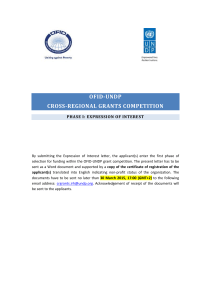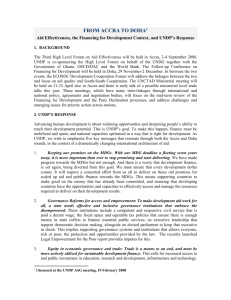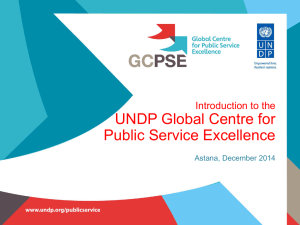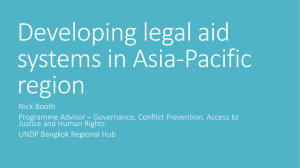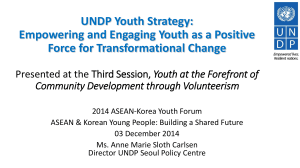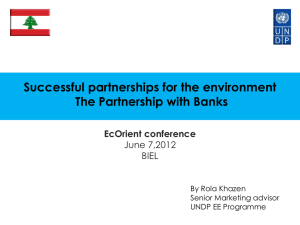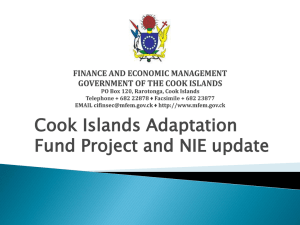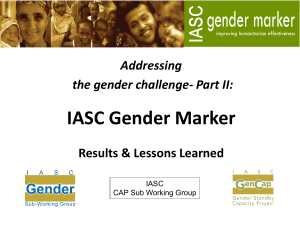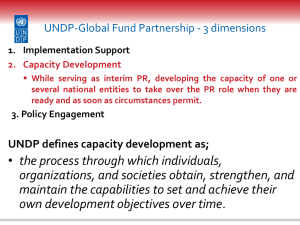Who and How to Finance the post-2015 Sustainable
advertisement
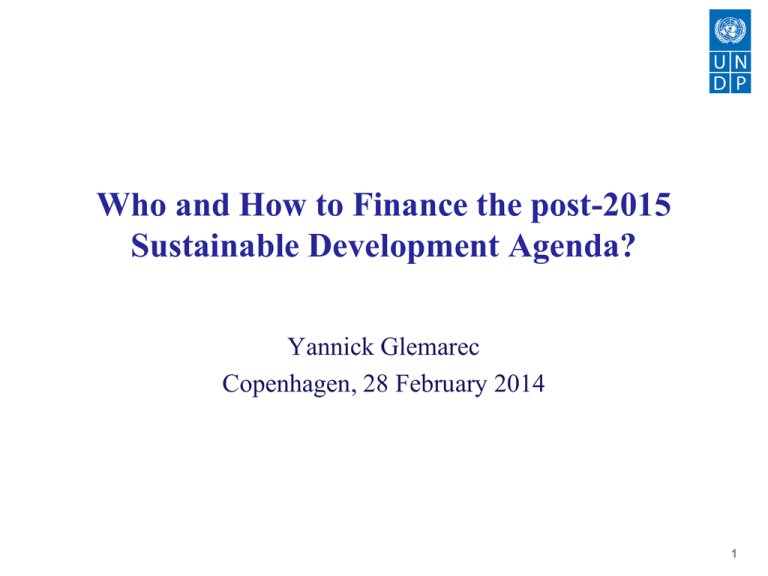
Who and How to Finance the post-2015 Sustainable Development Agenda? Yannick Glemarec Copenhagen, 28 February 2014 1 Part I The mandatory Universality of Sustainable Development Goals 2 Financing Needs for Environment and Climate far exceed current levels of Official Development and Climate Finance UNDP: Human Development Report 2011/12 3 Costs Versus Investment Source: Global GHG Abatement Cost Curve v2, McKinsey (2009) 4 Global investment in clean energy Source: Bloomberg New Energy Finance (2013) 5 The capital intensity of renewable energy Source: UNDP, Derisking Renewable Energy Investment (2013). See Annex A of the report for full assumptions. 6 Renewable energy vs fossil-fuel energy Developed vs. developing countries Source: UNDP, Derisking Renewable Energy Investment (2013). See Annex A of the report for full assumptions. All assumptions (technology costs, capital structure etc.) except for financing costs are kept constant between the developed and developing country. Operating costs appear as a lower contribution to LCOE in developing countries due to discounting effects from higher financing costs. 7 Mandatory Universality 8 Creating Attractive Risk/Reward Profile for Green Investment 9 Challenges to Financing the Post-2015 ERA • Reforming Financial Markets. • Transforming sector markets efficiently to align corporate and household finance with global and national sustainable development goals • Increasing sources of public finance to create enabling policy environments and catalyze private finance • Enhancing the capacity of developing countries to access, combine and sequence development finance to support market transformation 10 Part II Market Transformation for Sustainable Development 11 Market Transformation to Scale Up Green Investment Source: Yannick Glemarec, 2011 12 Selecting a public instrument mix to catalyse renewable energy investment Source: UNDP, Derisking Renewable Energy Investment (2013). 13 Illustrative modelling case-study for South Africa (8.4 GW, wind): risk waterfalls Source: UNDP, Derisking Renewable Energy Investment (2013). Data obtained from interviews with wind investors and developers. See Annex A of the report for full assumptions. The post-derisking cost of debt and equity show the average impacts over a 20 year modelling period, assuming linear timing effects. 14 Illustrative modelling results for South Africa (8.4 GW, wind) Source: UNDP, Derisking Renewable Energy Investment (2013). See Chapter 3 and Annex A of the report for full assumptions. 15 Financing On-Grid Wind Power Market Transformation Project Financing (Illustrative) Public Instrument Package (Illustrative – on-grid) Debt (lenders, bond issuance, etc.) Equity (from investors) Select Cornerstone Instrument Examples: Auctioning Construction Contract Feed-in tariff Policy Derisking Examples: Quality standards O&M skills Financial Derisking Examples: Loan guarantees Public loans Direct Incentives Project Company Operation & Maintenance Contract Off-take Contract (e.g., a power purchase agreement) Source: Adapted from Principles of Project Finance Examples: Dev. Bank Capital subsidy FiT premium Project Company Credit enhancement Capital Markets Public awareness issues Corporate bonds Public grants Soft loans electricity rates/ PBP Source: UNDP, Derisking Renewable Energy Investment (2013), adapted. Climate Bond Financing (Illustrative) Source: UNDP 16 Part III New Sources of Finance for Sustainable Development 17 Contribution to 5-year Cumulative Global GDP (constant 2005 US$) 18 North-South Flows 1990-2010 Source: Jenks and Jones, 2013 19 Finance Available to Developing Countries EU, 2013 20 Domestic Revenue Mobilization • Broadening tax bases • Fiscal reforms: from fossil fuel subsidies to polluter fines and reduction of loopholes • Curbing Illegal flows and aggressive transfer pricing • Tapping private wealth • Commodities and Sovereign Wealth Funds • Innovative sources of finance: diaspora bonds and remittance-backed bonds; resources-forinfrastructure; 21 Subsidies and Social Spending, 2010 22 Climate Finance vs. fossil fuel subsidies 23 Sovereign Wealth Funds 24 Potential Sources of Innovative Climate Finance 1. Public finance from climate sources Phase out of regressive fossil fuel subsidies Fossil fuel extraction royalties/licenses AAU auction proceeds Emission Trading Schemes (ETS) auction proceeds Carbon taxes/Carbon export optimization taxes Marine and aviation/bunker fuel levies Offset levies Wires charge on electricity production 2. Public finance from non-climate sources ‘Tobin’ tax, taxing revenues from financial transactions Leveraging of IMF Special Drawing Rights 3. Carbon markets 4. Other international financing proposals Debt for clean energy swap International Lottery 25 Global Networks and Alliances • The “Summary of Commitments” of the UN SG Summit on maternal and child health documents more than $ 40 billion of promises over a five year period from: – – – – 35 countries in attendance; 54 civil society organizations (the Gate Foundation pledged $ 1.5 billion); Private companies (Merck committed $ 840 million for HIV prevention and treatment); Multilateral agencies (WHO, GAVI, WB, etc.) • Similar fluid and dynamic coalitions are coalescing around all major collactive challenges. 26 ODA in the “Post-2015” Era • The expanding set of global objectives: Peace, Poverty, Equality and Environmental Sustainability; • The New faces of poverty and equity; • The fiscal capacity of low-income countries, fragile states and some small island states remain very limited; • Exposure and countries’ capacities to cope with shocks vary; • Conflicts and negative development; • Common and differentiated responsibilities for global commons (compensation, trade or ODA?); • A number of innovative financing instruments required a global cooperation; • Regional and thematic unbalance of private capital flows; • Markets are public-private partnerships, not platonic entities from high on; • The Complexity of Sustainable Development Finance. 27 Part IV Green Finance Preparedness 28 Climate Change Finance: Sources, Agents and Channels Source: Adapted by Yannick Glemarec from Atteridge and others (2009) 29 Accessing the Adaptation Fund • Direct access is about developing institutions that have capacities for financial management, integrity, transparency and selfinvestigatory powers; • UNDP encourages countries to develop their institutions to qualify for direct access. 30 UNDP’s Approach to assist countries to plan for, access, deliver and report on finance for low emission growth Prepare Green LECRDS • Assess needs and priorities, and identify barriers to investment • Identify policy mix and sources of financing Green Markets Formation Development of Implementation Capacities • Directly access • Implement and finance execute project, programme, • Blend and sector-wide combine finance approaches • Formulate • Build local supply project, of expertise and progamme, skills sector-wide Supporting national systems through this process for approaches to • Coordinate access finance effectively implementation helps countries to use finance Monitor, Report & Verify • Allows to formulate transparent sectorwide approaches climate finance Building capacities for planning, accessing, delivering and MRV ensures climate finance is available and effective in all countries 31 Formulation of Low Emission Climate Resilient Strategy 32 Financing Transformation Approaches International Public Finance (Global Vertical Funds) Scaled-up Mitigation Actions = Policy & Financial De-risking International Public/ Private Finance (Carbon Markets) + Performance -based Payments X Leveraged Private Financial Flows Tax Credits Carbon Offsets Domestic Public Finance (National Climate Funds) Public/Private Finance (Tariff premium) 33 National Climate Funds to Support Transformative Changes Strengthening national capacities and research Mali National Policy on Climate Change Integration of climate change at the level of sector based policies STRATEGIC PLAN 2014 (RESULT FRAMEWORK) PROGRAMMERELATED FRAMEWORK Mali National Strategy on Climate Change (2012-2017) Integration of climate change at the level of territorial policies Incite the private sector to participate in the national effort regarding climate change Mali National Climate Fund 34 UNDP’s support for Green Finance Preparedness in China Formulate provincial strategies Green Markets Formation • UNDP supported formulation of 32 provincial climate change programmes to implement national strategy • Identified priority mitigation and adaptation priority measures and associated costs • UNDP supported development of 2 energy efficient roadmaps • Assisted efforts to gradually develop a carbon market including a national emissions trading scheme Develop Implementation Capacities • UNDP contributed to the design of China’s first climate change think-tank – National Centre for Climate Change Strategy and International Cooperation Monitor, Report & Verify • UNDP supported development of national GHG inventory in framework of National Communications • Critical for emission trading systems and formulation of transparent sectoral NAMAs 35 Many tools available Online 36

